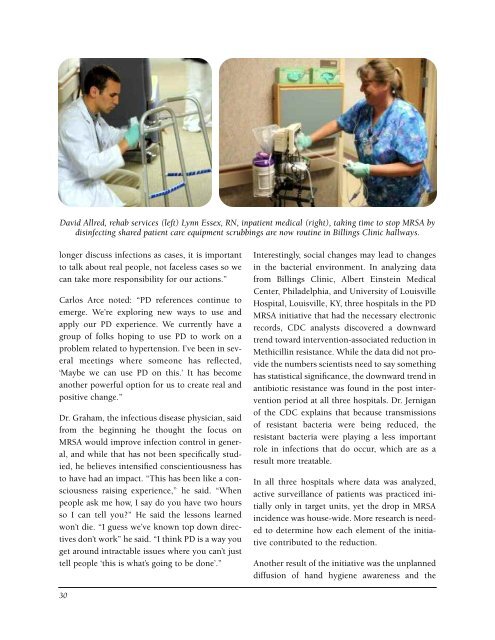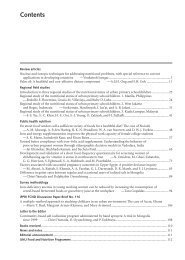From Invisible to Visible - Positive Deviance Initiative
From Invisible to Visible - Positive Deviance Initiative
From Invisible to Visible - Positive Deviance Initiative
Create successful ePaper yourself
Turn your PDF publications into a flip-book with our unique Google optimized e-Paper software.
David Allred, rehab services (left) Lynn Essex, RN, inpatient medical (right), taking time <strong>to</strong> s<strong>to</strong>p MRSA by<br />
disinfecting shared patient care equipment scrubbings are now routine in Billings Clinic hallways.<br />
longer discuss infections as cases, it is important<br />
<strong>to</strong> talk about real people, not faceless cases so we<br />
can take more responsibility for our actions.”<br />
Carlos Arce noted: “PD references continue <strong>to</strong><br />
emerge. We’re exploring new ways <strong>to</strong> use and<br />
apply our PD experience. We currently have a<br />
group of folks hoping <strong>to</strong> use PD <strong>to</strong> work on a<br />
problem related <strong>to</strong> hypertension. I’ve been in several<br />
meetings where someone has reflected,<br />
‘Maybe we can use PD on this.’ It has become<br />
another powerful option for us <strong>to</strong> create real and<br />
positive change.”<br />
Dr. Graham, the infectious disease physician, said<br />
from the beginning he thought the focus on<br />
MRSA would improve infection control in general,<br />
and while that has not been specifically studied,<br />
he believes intensified conscientiousness has<br />
<strong>to</strong> have had an impact. “This has been like a consciousness<br />
raising experience,” he said. “When<br />
people ask me how, I say do you have two hours<br />
so I can tell you?” He said the lessons learned<br />
won’t die. “I guess we’ve known <strong>to</strong>p down directives<br />
don’t work” he said. “I think PD is a way you<br />
get around intractable issues where you can’t just<br />
tell people ‘this is what’s going <strong>to</strong> be done’.”<br />
Interestingly, social changes may lead <strong>to</strong> changes<br />
in the bacterial environment. In analyzing data<br />
from Billings Clinic, Albert Einstein Medical<br />
Center, Philadelphia, and University of Louisville<br />
Hospital, Louisville, KY, three hospitals in the PD<br />
MRSA initiative that had the necessary electronic<br />
records, CDC analysts discovered a downward<br />
trend <strong>to</strong>ward intervention-associated reduction in<br />
Methicillin resistance. While the data did not provide<br />
the numbers scientists need <strong>to</strong> say something<br />
has statistical significance, the downward trend in<br />
antibiotic resistance was found in the post intervention<br />
period at all three hospitals. Dr. Jernigan<br />
of the CDC explains that because transmissions<br />
of resistant bacteria were being reduced, the<br />
resistant bacteria were playing a less important<br />
role in infections that do occur, which are as a<br />
result more treatable.<br />
In all three hospitals where data was analyzed,<br />
active surveillance of patients was practiced initially<br />
only in target units, yet the drop in MRSA<br />
incidence was house-wide. More research is needed<br />
<strong>to</strong> determine how each element of the initiative<br />
contributed <strong>to</strong> the reduction.<br />
Another result of the initiative was the unplanned<br />
diffusion of hand hygiene awareness and the<br />
30

















